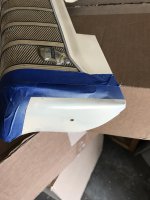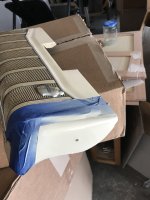We cannot see it in the pictures as there is no "before" picture. But often when you think it has been painted with a thick paint it is actually covered in celluloid and not painted.
The best way to tell whether an aluminium part (like a grille) is painted or covered with celluloid is to check where it has holes. When the part is covered with celluloid only the top has celluloid and inside the holes or cutouts you see the aluminium (or wood if it's a wooden part). When the part is painted (spray-painted typically) the paint is also in the holes and cutouts. it is also never a "thick enamel paint", because industrially painted parts (spray-painted) always have a thin coat of paint. The part you have has no paint in the hole, so it is most likely covered with celluloid, and was not painted. (Yet another way to tellis to feel both sides of the metal. A painted side feels almost as cold as the blank back side. A side covered with celluloid feels less cold (as the celluloid does not absorb the warmth of you finger as much as the metal does).
Other than by looking at holes it can be hard to determine whether a surface was painted or covered with celluloid. The shiny outside surface can look very much alike. I recently worked on a small Pigini which looked like it was covered with black celluloid (except for the obviously painted grille with paint in all the cutouts). But on closer inspection (looking inside the holes for the bellow pins for instance) it became clear that the treble side was painted and the bass side was covered with celluloid... it can be tricky to see whether something is painted or covered with celluloid!


